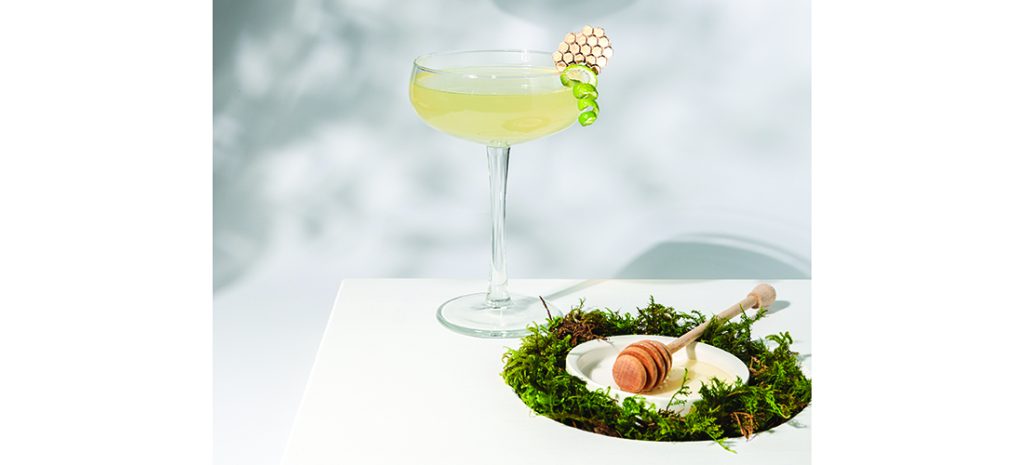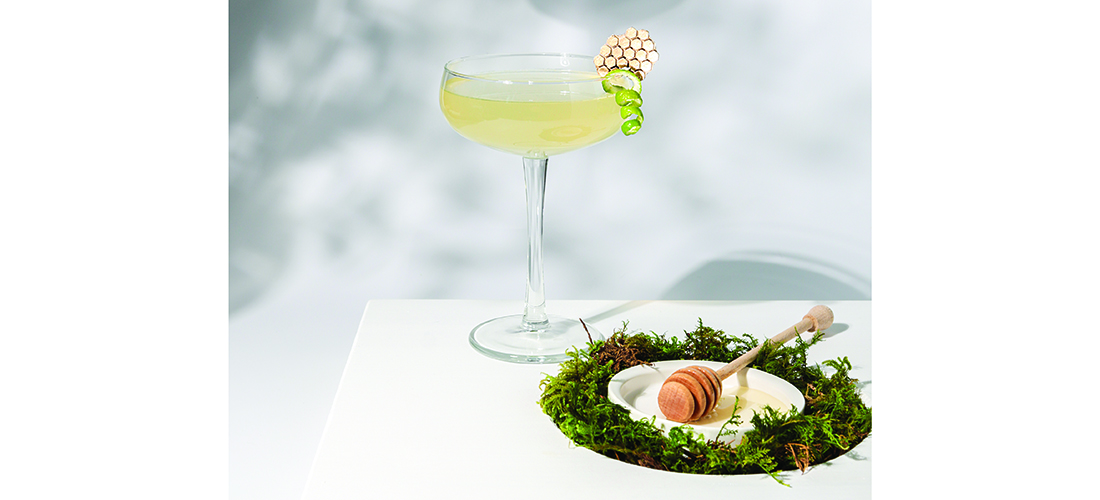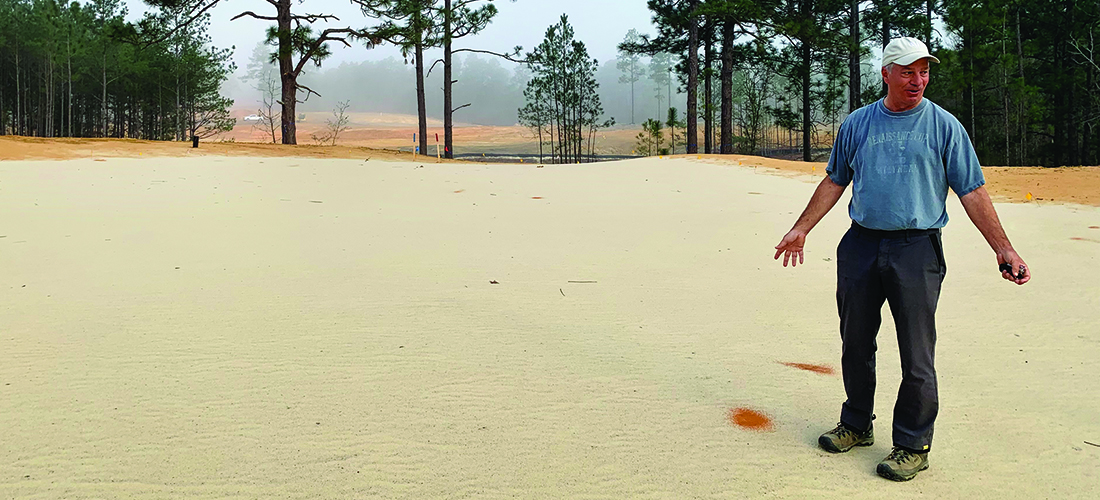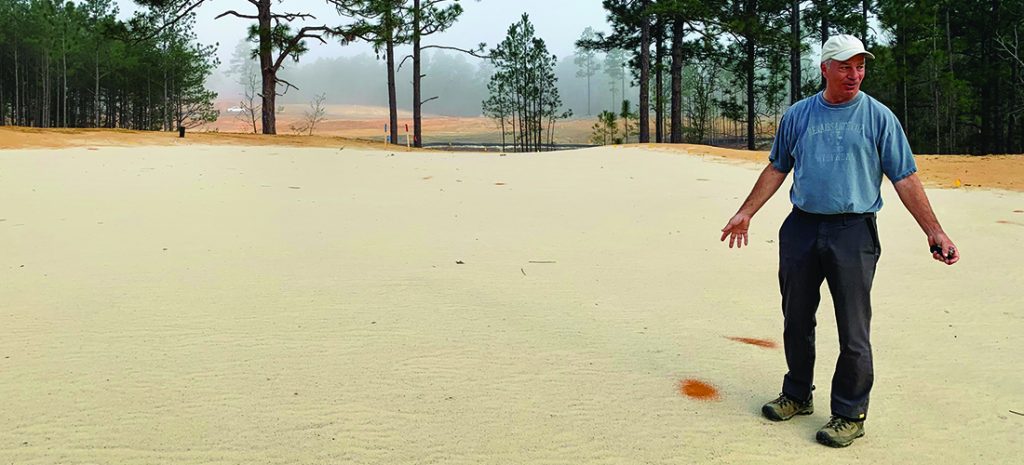Ten Spot
Adding to the Pinehurst allure
By Lee Pace
Tom Doak was about 10 years old when he started taking family vacations and tagging along on his father’s business trips from their home in Stamford, Connecticut, to eminent golf destinations like Pebble Beach, Cypress Point, Harbour Town and Pinehurst. He had learned to play on a local municipal course named Sterling Farms, and it didn’t take much for the golf bug to bite. And there was a nascent sense that designing golf holes might be a cool way to spend a life.
“When I was a kid, all I wanted to do was to go outside and play,” says Doak, now 62. “When I discovered golf, I was amazed that such a large parcel of land would be devoted to a game. It’s a safe space where it’s OK to be excited about a good shot, to curse a bad one, to laugh at your friends, and to revel in the beauty of nature.”
One of his father’s business associates gave him a copy of the World Atlas of Golf, an early 1970s tome with text and images of courses from California to Scotland, Florida to Australia. “I pretty much memorized the book,” he says.
On a visit to Hilton Head, Doak picked up a small hole-by-hole guide to the Harbour Town Golf Links, which had just opened a few years earlier and was the toast of the PGA Tour and the golf world for the way Pete Dye routed the holes through the Spanish oaks and around the fingers of Calibogue Sound. The hole descriptions were crafted by Charles Price, the noted golf historian who was living in Hilton Head at the time, and was friends with Dye and island developer Charles Fraser.
“It had a diagram of every hole and a description of how to play it, just two or three sentences, very simple, something a 10-year-old could understand perfectly,” Doak says. “It hit me — this is why golf holes are built a certain way. I saw all these great golf courses at a very early age, and I thought, ‘They are all great, but they are totally different.’ I got a great understanding early on that there’s not a simple answer to why a golf course is great.”
He’s been chasing those answers ever since.
Doak pursued a degree in landscape architecture at Cornell University, graduating in 1982 and spending a year in the United Kingdom visiting more than 170 golf courses and caddying for two months at St. Andrews. He landed a job on Dye’s construction crew and helped build Long Cove Club on Hilton Head, then spent six years building courses for Dye while moonlighting as a writer, establishing a niche with Golf magazine as its golf course architecture chief. In the late 1980s, he began compiling short critiques of the hundreds of courses he’d played and seen and giving each a numerical rating of one through 10. The musings were first intended just for a network of friends but evolved into his 1996 book, The Confidential Guide to Golf Courses.
Pinehurst No. 2 was featured in that book as one of 31 courses designated as “The Gourmet’s Choice,” certainly with a 10 ranking, and Doak lauded the layout and the Donald Ross-designed green complexes. “Unquestionably his masterpiece, and a certifiable work of genius,” Doak wrote.
After the 2005 U.S. Open at Pinehurst, sometime around the 2008 U.S. Amateur held on No. 2, Doak was traveling through North Carolina with an intern on his now-established Renaissance Golf Design firm. They stopped in Pinehurst, and he walked the golf course again.
“I first saw No. 2 in the early 1970s,” Doak remembers. “I was 10 or 12 and was visiting with my parents. I’ve seen it at various times over 40 years. It’s always been one of my favorite golf courses. What made it cool was a bunch of little stuff, little ridges, touches of wire grass here and there. The strategy of the fairways stood out. There used to be places on the golf course where the fairway would widen out behind a bunker and you’d try to get way over in the left corner of the fairway to get at a pin on the right side of the green.
“On that last trip, it seemed like all of that had gone away. They were narrowing it up for major championships and getting the grass to grow nice and thick. All the texture and angles were gone. That’s what made the golf course — all the subtleties. I said that if I were to rate it again, I’d give it a seven or eight — but not a 10.”
He put his opinions out for the world to see on the message board of GolfClubAtlas.com. Among the comments he made was that No. 2 looked “like an aged relative with dementia. It was sad.”
Tom Pashley, at the time the marketing director for Pinehurst before ascending to the CEO position in 2014, saw the comment and printed out the entire thread of the message board conversation and passed it along to Don Padgett II, the president and CEO of the resort from 2004-14. Doak’s opinions were among a handful of observations that marinated in Padgett’s mind and led to the club hiring Bill Coore and Ben Crenshaw in the fall of 2009 to strip the course of its monochromatic green, and restore the textures and haphazard features and boundaries of the holes as they existed when Ross arrived at his final routing in 1935.
On this Sunday morning Doak smiles over breakfast at the Track Restaurant in Pinehurst, just minutes before driving 2 miles south to the site of the No. 10 course he’s building for Pinehurst on property that once housed the Dan Maples-designed Pit Golf Links.
“I didn’t expect them to listen to me, and I know that’s not the best way to get the job to help them fix it,” he says. “But it was a great golf course and was not going in the right direction, and I just said something. Fortunately, Bill and Ben said pretty much the same thing, just much more subtly.”
In the decade since, the design operations of Doak and Coore & Crenshaw have each thrived as the golf marketplace has embraced their respective styles of hands-on attention and their preference to working on rugged, sandy landscapes, where ample drainage allows a limitless palette of design features. While working on the No. 2 restoration in 2010-11, Coore routed a course for Pinehurst that was going to be Pinehurst No. 9 — this before the resort bought the former Pinehurst National course in 2012 and made it No. 9. Now in the post-COVID glow of the golf industry explosion in general and the robust demand among members and the traveling public for Pinehurst’s existing nine courses, Pinehurst owner Robert Dedman Jr. and Pashley believed in 2022 it was time to pull the trigger on the new course.
Coore and Crenshaw was booked several years out but Doak had a hole in his schedule that would allow him to move construction personnel to Pinehurst in late 2022 and through the fall of 2023 to build a new course that could open in time for the 2024 U.S. Open set for Pinehurst. Now the little kid who was smitten with the look of Pinehurst No. 2 in the early 1970s before it got greened-over is leaving his mark in the Sandhills, positioning his course among some 40 others he’s designed, including the standouts at Pacific Dunes, Cape Kidnappers, Barnbougle Dunes, Ballyneal and Streamsong.
“We’ve got a really cool piece of land,” Doak says as he navigates his truck through the sand and rough-cut passages of the pine forests and the stone quarry that sat there before a golf course was first built in the 1980s. On this morning, crews are just days away from beginning to sod some of the early fairways.
“This ground has more variety and a different feeling to it than any of the other courses at the resort,” Doak says. “There is a lot going on on this land. The course will start gentle, then it gets more dramatic at the quarry and then reaches the high ground, where we’ve got great long-range views. It’s a big piece of land, and you feel like you have all the pieces of the puzzle. It gives you the opportunity to do something really different.”
Doak is undaunted putting his ideas into the dirt in such close proximity to one of the world’s top courses. He designed Sebonack Golf Club on Long Island in the shadows of two of his favorite courses, The National Golf Links and Shinnecock Hills Golf Club, and built The Renaissance Club next door to Muirfield on the Scottish coast. He ignores the pressure and embraces the inspiration.
On one of his visits to Pinehurst, he stayed in Dornoch Cottage, the former Donald Ross home sitting near the third and fifth greens of No. 2.
“I’d take our guys out early in the morning and look at those greens,” he says. “‘This is what a great green looks like,’ I’d say.”
On this Sunday morning, Doak admits to having experienced a challenging day on Friday with his shapers, trying to get a couple of greens to look just so.
“I said let’s go to No. 2 and see what great greens look like and get back in the game.” PS
Lee Pace has written over four decades about all of the golf architects at Pinehurst, from Donald Ross to Gil Hanse. Contact him at leepace7@gmail.com and follow him on Instagram at @leepaceunc.




